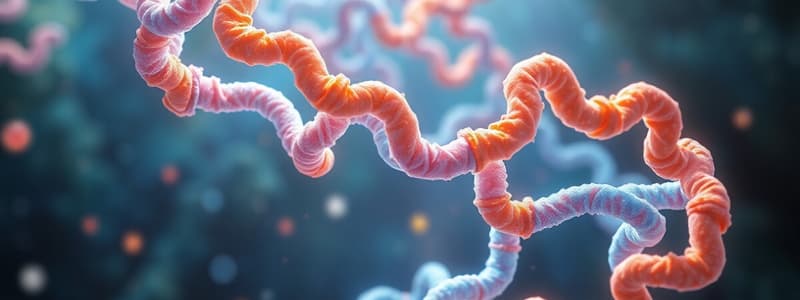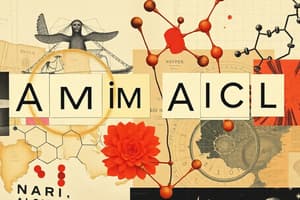Podcast
Questions and Answers
Which statement accurately describes amino acids involved in body proteins?
Which statement accurately describes amino acids involved in body proteins?
- Only D-amino acids are involved in protein synthesis.
- Both D and L amino acids participate equally in protein synthesis.
- Only non-polar amino acids can form proteins.
- L α-amino acids are critical for protein formation. (correct)
What property of amino acids allows them to act as both acids and bases?
What property of amino acids allows them to act as both acids and bases?
- Hydrophilic nature
- Hydrophobic interactions
- Amphoteric properties (correct)
- Optical isomerism
Which amino acid is known for being a neurotransmitter?
Which amino acid is known for being a neurotransmitter?
- Glycine
- Valine
- Glutamate (correct)
- Alanine
How are amino acids classified based on their structure?
How are amino acids classified based on their structure?
Which of the following is a branched chain amino acid?
Which of the following is a branched chain amino acid?
Which amino acid is an example of an aliphatic amino acid?
Which amino acid is an example of an aliphatic amino acid?
Which of the following amino acids contains a hydroxyl group?
Which of the following amino acids contains a hydroxyl group?
Which of the following amino acids is classified as a basic amino acid?
Which of the following amino acids is classified as a basic amino acid?
Which is NOT considered a function of amino acids?
Which is NOT considered a function of amino acids?
Which amino acid is characterized by the presence of an indole ring?
Which amino acid is characterized by the presence of an indole ring?
What characterizes the isomerism of amino acids?
What characterizes the isomerism of amino acids?
Which of the following statements about essential amino acids is true?
Which of the following statements about essential amino acids is true?
Which amino acid is classified under aromatic amino acids?
Which amino acid is classified under aromatic amino acids?
What type of amino acids are Cysteine and Methionine classified as?
What type of amino acids are Cysteine and Methionine classified as?
Which of the following describes nonessential amino acids?
Which of the following describes nonessential amino acids?
Which amino acids are known as monopeptide amino acids based on their structure?
Which amino acids are known as monopeptide amino acids based on their structure?
Which amino acids are exclusively ketogenic?
Which amino acids are exclusively ketogenic?
Which amino acids can give rise to both glucose and ketone bodies?
Which amino acids can give rise to both glucose and ketone bodies?
At the isoelectric point, which statement is true about the amino acid structure?
At the isoelectric point, which statement is true about the amino acid structure?
Which amino acid pair includes both essential and nonessential amino acids?
Which amino acid pair includes both essential and nonessential amino acids?
Which amino acids are classified solely as glucogenic?
Which amino acids are classified solely as glucogenic?
What is the primary functional property of amino acids at the isoelectric point?
What is the primary functional property of amino acids at the isoelectric point?
Which of these amino acids is considered essential?
Which of these amino acids is considered essential?
Which amino acid is categorized as both glucogenic and ketogenic?
Which amino acid is categorized as both glucogenic and ketogenic?
Flashcards are hidden until you start studying
Study Notes
Amino Acid Structure and Function
- There are hundreds of naturally occurring amino acids, but 20 are used in protein synthesis, and these have genetic codes on DNA.
- Amino acids are organic acids with an amino group (NH2) replacing a hydrogen atom.
- The amino group is typically attached to the alpha-carbon atom next to the -COOH group.
- Most amino acids can exist in D or L optical isomers, but only L-alpha-amino acids are used in protein formation.
- D-amino acids are found in certain organisms and plants.
Functions of Amino Acids
- Amino acids are the building blocks of proteins.
- They serve as energy sources, being oxidized to urea and carbon dioxide.
- Some amino acids have vital biological roles, such as neurotransmitters like glutamate and GABA.
- Many amino acids are used to synthesize other molecules, like glycine, which makes up 33% of collagen protein.
Amino Acid Classification
According to Structure
- Aliphatic Amino Acids: Lack a ring structure.
- Neutral: Examples include glycine and alanine.
- Branched Chain: Examples include valine, leucine, and isoleucine.
- Hydroxy-containing: Examples include serine, threonine, and tyrosine.
- Sulfur-containing: Examples include cysteine and methionine.
- Aromatic Amino Acids: Contain an aromatic ring (benzene or phenolic). Examples include phenylalanine and tyrosine.
- Heterocyclic Amino Acids: Contain a ring structure. Examples include tryptophan, histidine, and proline.
According to Nutritional Classification
- Essential Amino Acids: Cannot be synthesized by the human body and must be obtained from food. Examples include isoleucine, leucine, lysine, methionine, phenylalanine, threonine, tryptophan, valine, arginine, and histidine.
- Nonessential Amino Acids: Can be synthesized by the human body. Examples include alanine, asparagine, aspartate, cysteine, glutamate, glutamine, glycine, proline, serine, and tyrosine.
According to Metabolic Fate
- Glucogenic: Can be converted into glucose.
- Ketogenic: Can be converted into ketone bodies.
- Glucogenic and Ketogenic: Can be converted into both glucose and ketone bodies.
- Leucine and lysine are the only purely ketogenic amino acids.
- Isoleucine, tryptophan, tyrosine, and phenylalanine are glucogenic and ketogenic.
Amphoteric Properties of Amino Acids
- Amino acids have both carboxyl and amino groups, making them capable of acting as acids and bases.
- At the isoelectric point, the amino group is protonated (+ charge), and the acid group is deprotonated (- charge).
- This results in a zwitterion, a molecule with both a positive and negative charge.
Studying That Suits You
Use AI to generate personalized quizzes and flashcards to suit your learning preferences.




